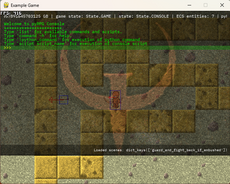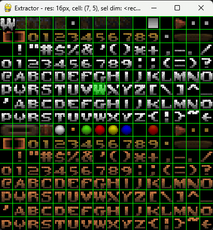2DVectorClass — wiki
This is a 2D vector class, has operator overloading (can use with tuples or lists), uses slots for perforance, is picklable, implements list interface (so it's compatible with pygame functions), has a fair bit of high level vector operators (for performance and readability) and has unit tests.
################## http://www.pygame.org/wiki/2DVectorClass ##################
import operator
import math
class Vec2d(object):
"""2d vector class, supports vector and scalar operators,
and also provides a bunch of high level functions
"""
__slots__ = ['x', 'y']
def __init__(self, x_or_pair, y = None):
if y == None:
self.x = x_or_pair[0]
self.y = x_or_pair[1]
else:
self.x = x_or_pair
self.y = y
def __len__(self):
return 2
def __getitem__(self, key):
if key == 0:
return self.x
elif key == 1:
return self.y
else:
raise IndexError("Invalid subscript "+str(key)+" to Vec2d")
def __setitem__(self, key, value):
if key == 0:
self.x = value
elif key == 1:
self.y = value
else:
raise IndexError("Invalid subscript "+str(key)+" to Vec2d")
# String representaion (for debugging)
def __repr__(self):
return 'Vec2d(%s, %s)' % (self.x, self.y)
# Comparison
def __eq__(self, other):
if hasattr(other, "__getitem__") and len(other) == 2:
return self.x == other[0] and self.y == other[1]
else:
return False
def __ne__(self, other):
if hasattr(other, "__getitem__") and len(other) == 2:
return self.x != other[0] or self.y != other[1]
else:
return True
def __nonzero__(self):
return bool(self.x or self.y)
# Generic operator handlers
def _o2(self, other, f):
"Any two-operator operation where the left operand is a Vec2d"
if isinstance(other, Vec2d):
return Vec2d(f(self.x, other.x),
f(self.y, other.y))
elif (hasattr(other, "__getitem__")):
return Vec2d(f(self.x, other[0]),
f(self.y, other[1]))
else:
return Vec2d(f(self.x, other),
f(self.y, other))
def _r_o2(self, other, f):
"Any two-operator operation where the right operand is a Vec2d"
if (hasattr(other, "__getitem__")):
return Vec2d(f(other[0], self.x),
f(other[1], self.y))
else:
return Vec2d(f(other, self.x),
f(other, self.y))
def _io(self, other, f):
"inplace operator"
if (hasattr(other, "__getitem__")):
self.x = f(self.x, other[0])
self.y = f(self.y, other[1])
else:
self.x = f(self.x, other)
self.y = f(self.y, other)
return self
# Addition
def __add__(self, other):
if isinstance(other, Vec2d):
return Vec2d(self.x + other.x, self.y + other.y)
elif hasattr(other, "__getitem__"):
return Vec2d(self.x + other[0], self.y + other[1])
else:
return Vec2d(self.x + other, self.y + other)
__radd__ = __add__
def __iadd__(self, other):
if isinstance(other, Vec2d):
self.x += other.x
self.y += other.y
elif hasattr(other, "__getitem__"):
self.x += other[0]
self.y += other[1]
else:
self.x += other
self.y += other
return self
# Subtraction
def __sub__(self, other):
if isinstance(other, Vec2d):
return Vec2d(self.x - other.x, self.y - other.y)
elif (hasattr(other, "__getitem__")):
return Vec2d(self.x - other[0], self.y - other[1])
else:
return Vec2d(self.x - other, self.y - other)
def __rsub__(self, other):
if isinstance(other, Vec2d):
return Vec2d(other.x - self.x, other.y - self.y)
if (hasattr(other, "__getitem__")):
return Vec2d(other[0] - self.x, other[1] - self.y)
else:
return Vec2d(other - self.x, other - self.y)
def __isub__(self, other):
if isinstance(other, Vec2d):
self.x -= other.x
self.y -= other.y
elif (hasattr(other, "__getitem__")):
self.x -= other[0]
self.y -= other[1]
else:
self.x -= other
self.y -= other
return self
# Multiplication
def __mul__(self, other):
if isinstance(other, Vec2d):
return Vec2d(self.x*other.x, self.y*other.y)
if (hasattr(other, "__getitem__")):
return Vec2d(self.x*other[0], self.y*other[1])
else:
return Vec2d(self.x*other, self.y*other)
__rmul__ = __mul__
def __imul__(self, other):
if isinstance(other, Vec2d):
self.x *= other.x
self.y *= other.y
elif (hasattr(other, "__getitem__")):
self.x *= other[0]
self.y *= other[1]
else:
self.x *= other
self.y *= other
return self
# Division
def __div__(self, other):
return self._o2(other, operator.div)
def __rdiv__(self, other):
return self._r_o2(other, operator.div)
def __idiv__(self, other):
return self._io(other, operator.div)
def __floordiv__(self, other):
return self._o2(other, operator.floordiv)
def __rfloordiv__(self, other):
return self._r_o2(other, operator.floordiv)
def __ifloordiv__(self, other):
return self._io(other, operator.floordiv)
def __truediv__(self, other):
return self._o2(other, operator.truediv)
def __rtruediv__(self, other):
return self._r_o2(other, operator.truediv)
def __itruediv__(self, other):
return self._io(other, operator.floordiv)
# Modulo
def __mod__(self, other):
return self._o2(other, operator.mod)
def __rmod__(self, other):
return self._r_o2(other, operator.mod)
def __divmod__(self, other):
return self._o2(other, operator.divmod)
def __rdivmod__(self, other):
return self._r_o2(other, operator.divmod)
# Exponentation
def __pow__(self, other):
return self._o2(other, operator.pow)
def __rpow__(self, other):
return self._r_o2(other, operator.pow)
# Bitwise operators
def __lshift__(self, other):
return self._o2(other, operator.lshift)
def __rlshift__(self, other):
return self._r_o2(other, operator.lshift)
def __rshift__(self, other):
return self._o2(other, operator.rshift)
def __rrshift__(self, other):
return self._r_o2(other, operator.rshift)
def __and__(self, other):
return self._o2(other, operator.and_)
__rand__ = __and__
def __or__(self, other):
return self._o2(other, operator.or_)
__ror__ = __or__
def __xor__(self, other):
return self._o2(other, operator.xor)
__rxor__ = __xor__
# Unary operations
def __neg__(self):
return Vec2d(operator.neg(self.x), operator.neg(self.y))
def __pos__(self):
return Vec2d(operator.pos(self.x), operator.pos(self.y))
def __abs__(self):
return Vec2d(abs(self.x), abs(self.y))
def __invert__(self):
return Vec2d(-self.x, -self.y)
# vectory functions
def get_length_sqrd(self):
return self.x**2 + self.y**2
def get_length(self):
return math.sqrt(self.x**2 + self.y**2)
def __setlength(self, value):
length = self.get_length()
self.x *= value/length
self.y *= value/length
length = property(get_length, __setlength, None, "gets or sets the magnitude of the vector")
def rotate(self, angle_degrees):
radians = math.radians(angle_degrees)
cos = math.cos(radians)
sin = math.sin(radians)
x = self.x*cos - self.y*sin
y = self.x*sin + self.y*cos
self.x = x
self.y = y
def rotated(self, angle_degrees):
radians = math.radians(angle_degrees)
cos = math.cos(radians)
sin = math.sin(radians)
x = self.x*cos - self.y*sin
y = self.x*sin + self.y*cos
return Vec2d(x, y)
def get_angle(self):
if (self.get_length_sqrd() == 0):
return 0
return math.degrees(math.atan2(self.y, self.x))
def __setangle(self, angle_degrees):
self.x = self.length
self.y = 0
self.rotate(angle_degrees)
angle = property(get_angle, __setangle, None, "gets or sets the angle of a vector")
def get_angle_between(self, other):
cross = self.x*other[1] - self.y*other[0]
dot = self.x*other[0] + self.y*other[1]
return math.degrees(math.atan2(cross, dot))
def normalized(self):
length = self.length
if length != 0:
return self/length
return Vec2d(self)
def normalize_return_length(self):
length = self.length
if length != 0:
self.x /= length
self.y /= length
return length
def perpendicular(self):
return Vec2d(-self.y, self.x)
def perpendicular_normal(self):
length = self.length
if length != 0:
return Vec2d(-self.y/length, self.x/length)
return Vec2d(self)
def dot(self, other):
return float(self.x*other[0] + self.y*other[1])
def get_distance(self, other):
return math.sqrt((self.x - other[0])**2 + (self.y - other[1])**2)
def get_dist_sqrd(self, other):
return (self.x - other[0])**2 + (self.y - other[1])**2
def projection(self, other):
other_length_sqrd = other[0]*other[0] + other[1]*other[1]
projected_length_times_other_length = self.dot(other)
return other*(projected_length_times_other_length/other_length_sqrd)
def cross(self, other):
return self.x*other[1] - self.y*other[0]
def interpolate_to(self, other, range):
return Vec2d(self.x + (other[0] - self.x)*range, self.y + (other[1] - self.y)*range)
def convert_to_basis(self, x_vector, y_vector):
return Vec2d(self.dot(x_vector)/x_vector.get_length_sqrd(), self.dot(y_vector)/y_vector.get_length_sqrd())
def __getstate__(self):
return [self.x, self.y]
def __setstate__(self, dict):
self.x, self.y = dict
########################################################################
## Unit Testing ##
########################################################################
if __name__ == "__main__":
import unittest
import pickle
####################################################################
class UnitTestVec2D(unittest.TestCase):
def setUp(self):
pass
def testCreationAndAccess(self):
v = Vec2d(111,222)
self.assertTrue(v.x == 111 and v.y == 222)
v.x = 333
v[1] = 444
self.assertTrue(v[0] == 333 and v[1] == 444)
def testMath(self):
v = Vec2d(111,222)
self.assertEqual(v + 1, Vec2d(112,223))
self.assertTrue(v - 2 == [109,220])
self.assertTrue(v * 3 == (333,666))
self.assertTrue(v / 2.0 == Vec2d(55.5, 111))
self.assertTrue(v / 2 == (55.5, 111))
self.assertTrue(v ** Vec2d(2,3) == [12321, 10941048])
self.assertTrue(v + [-11, 78] == Vec2d(100, 300))
self.assertTrue(v / [10,2] == [11.1,111])
def testReverseMath(self):
v = Vec2d(111,222)
self.assertTrue(1 + v == Vec2d(112,223))
self.assertTrue(2 - v == [-109,-220])
self.assertTrue(3 * v == (333,666))
self.assertTrue([222,888] / v == [2,4])
self.assertTrue([111,222] ** Vec2d(2,3) == [12321, 10941048])
self.assertTrue([-11, 78] + v == Vec2d(100, 300))
def testUnary(self):
v = Vec2d(111,222)
v = -v
self.assertTrue(v == [-111,-222])
v = abs(v)
self.assertTrue(v == [111,222])
def testLength(self):
v = Vec2d(3,4)
self.assertTrue(v.length == 5)
self.assertTrue(v.get_length_sqrd() == 25)
self.assertTrue(v.normalize_return_length() == 5)
self.assertTrue(v.length == 1)
v.length = 5
self.assertTrue(v == Vec2d(3,4))
v2 = Vec2d(10, -2)
self.assertTrue(v.get_distance(v2) == (v - v2).get_length())
def testAngles(self):
v = Vec2d(0, 3)
self.assertEqual(v.angle, 90)
v2 = Vec2d(v)
v.rotate(-90)
self.assertEqual(v.get_angle_between(v2), 90)
v2.angle -= 90
self.assertEqual(v.length, v2.length)
self.assertEqual(v2.angle, 0)
self.assertEqual(v2, [3, 0])
self.assertTrue((v - v2).length < .00001)
self.assertEqual(v.length, v2.length)
v2.rotate(300)
self.assertAlmostEqual(v.get_angle_between(v2), -60)
v2.rotate(v2.get_angle_between(v))
angle = v.get_angle_between(v2)
self.assertAlmostEqual(v.get_angle_between(v2), 0)
def testHighLevel(self):
basis0 = Vec2d(5.0, 0)
basis1 = Vec2d(0, .5)
v = Vec2d(10, 1)
self.assertTrue(v.convert_to_basis(basis0, basis1) == [2, 2])
self.assertTrue(v.projection(basis0) == (10, 0))
self.assertTrue(basis0.dot(basis1) == 0)
def testCross(self):
lhs = Vec2d(1, .5)
rhs = Vec2d(4,6)
self.assertTrue(lhs.cross(rhs) == 4)
def testComparison(self):
int_vec = Vec2d(3, -2)
flt_vec = Vec2d(3.0, -2.0)
zero_vec = Vec2d(0, 0)
self.assertTrue(int_vec == flt_vec)
self.assertTrue(int_vec != zero_vec)
self.assertTrue((flt_vec == zero_vec) == False)
self.assertTrue((flt_vec != int_vec) == False)
self.assertTrue(int_vec == (3, -2))
self.assertTrue(int_vec != [0, 0])
self.assertTrue(int_vec != 5)
self.assertTrue(int_vec != [3, -2, -5])
def testInplace(self):
inplace_vec = Vec2d(5, 13)
inplace_ref = inplace_vec
inplace_src = Vec2d(inplace_vec)
inplace_vec *= .5
inplace_vec += .5
inplace_vec /= (3, 6)
inplace_vec += Vec2d(-1, -1)
self.assertEqual(inplace_vec, inplace_ref)
def testPickle(self):
testvec = Vec2d(5, .3)
testvec_str = pickle.dumps(testvec)
loaded_vec = pickle.loads(testvec_str)
self.assertEqual(testvec, loaded_vec)
####################################################################
unittest.main()
########################################################################









